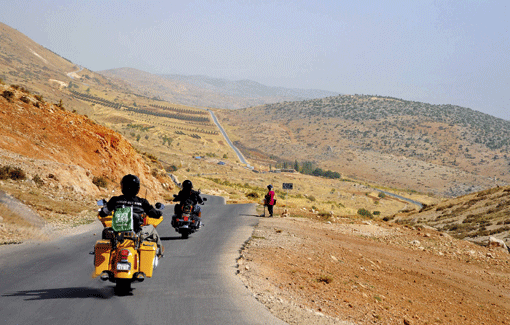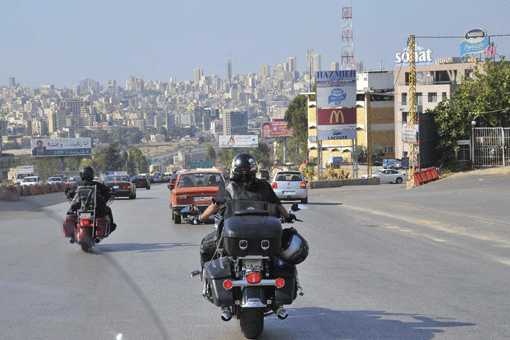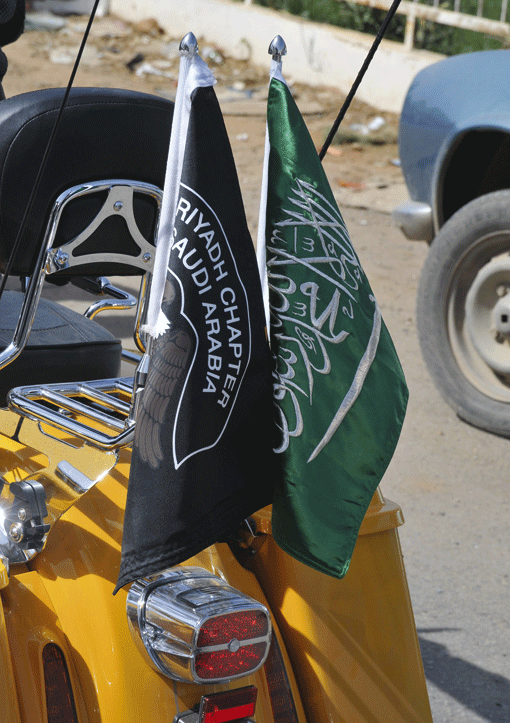
Travel
Touring Through Arabia

A memorable motor biking journey through Syria, Lebanon, Jordan and back to Saudi Arabia
By: Bizzie Frost
Last October, my husband and I parked our Harley-Davidson Road King motorcycle in our carport in Jeddah after riding 4,614 kilometres around Jordan, Syria, Lebanon and Saudi Arabia. The focal points of the journey were the 1st Official Lebanon Harley Owners’ Group (HOG) Tour in Beirut, and the 3rd Saudi National HOG Rally in Abha in the Asir mountains in southern Saudi Arabia.
Our trip began in Gurayat, close to the Saudi-Jordanian border. Our Harley (called “Maridadi”, a Swahili word meaning “stylish”) had been shipped there from Jeddah to join 17 bikes belonging to the Riyadh HOG Chapter. The first day’s ride was 325 kms and took us through Jordan to Damascus in Syria. At the Syrian border, we were met by a large group of bikers from Damascus who gave us a warm welcome into their country. They had arranged an official VIP escort for us and we rode into Damascus for the first time in a large convoy of 48 bikes. We caused quite a sensation when we all pulled up to park outside a restaurant in a busy downtown street. 
The next day, our Syrian friends escorted us out of the city and we rode the 111 kms to Beirut. In the Middle East, Lebanon has a great reputation for being a fun place to be so when they had announced their 1st Official HOG Tour, entries had came pouring in from Egypt, UAE, Qatar, Saudi Arabia, Jordan and Syria. The Lebanese are always enthusiastic about the beauty of their country and the fact that at certain times of the year, you can be snow skiing in the morning and basking in the sun on the beach in the afternoon. The country is three times as long as it is wide and it has four topographical ribbons running north to south that give it its variety. There is a narrow coastal strip running along the eastern shore of the Mediterranean Sea; then the interior is mountainous, with two major ranges: the Lebanon Mountains and the Anti Lebanon mountains. The huge and fertile Bekaa Valley divides these, with a history going back to Roman times when it was a source of grain for the Roman provinces in the Levant. Its impressive expanse is explained by the fact that it is part of the Great Rift Valley, which runs from Turkey all the way down through Africa as far as Mozambique.
We started our three-day tour of Lebanon on a very hot October morning. There were around 280 motorcycles with 100 pillion riders, and we were divided into more manageable groups of 60 bikes.
Beirut is a large, sprawling city with heavy traffic so it was a relief when we turned off the main highway and headed up into the hills. A narrow scenic road twisted its way up through farms and villages, and then along the steep sides of Wadi Tannourine. The going was very slow—about 40 kph—and oncoming traffic had to virtually stop to let us all pass. Our lunch stop was at the unassuming Al Mrouj Restaurant, surrounded by open fields and farmland.
Our afternoon ride took us further up into the Lebanon Mountains towards the Faraya ski resort, still on very narrow and sometimes broken roads. The temperature dropped dramatically, and in the late afternoon, we came over the crest of a hill and the huge expanse of the Bekaa Valley spread out before us. We continued through the rolling mountains where there was barely a sign of life, only the occasional shepherd and a nomad’s tent. In the dusk, we stopped at a point overlooking a valley to watch the lights of the groups behind and listen to the growl of their engines as they wound their way towards us. The rest of the ride up the mountain to the Mzaar Intercontinental was by the light of an almost full moon.
The following morning, all 280 bikes had to refuel at the tiny local fuel station, so we made sure we got there early. In our groups of 60, the narrow road led us down the barren, rolling hills with their ochre coloured rocks, occasional shepherds and sheep, and sporadic olive groves. The temperature began to rise and by the time we reached the bottom of the Bekaa Valley, it had soared to 40 degrees Celsius—much hotter than I had expected it to be in Lebanon.
Friendly local farming families came out to watch and wave as we went by and most of the traffic was farm-related: tractors and trailers, pick-up trucks, donkey carts. There was lots of litter on the roadsides, and although the roads were in poor condition with frequent potholes, there were still speed bumps in every village. It was an interesting ride, but I can’t say that I enjoyed the intense heat and it was a relief to stop in Hasbaya at Al Bahsasa, a picturesque restaurant, surrounded by water, for our lunch break.
The morning ride had been through the poorer part of the valley, but in the afternoon, the farms in the central part around Zahle became visibly wealthier and more picturesque. The roads were much better and we rode through beautifully kept vineyards and orchards,
Our second night was in Hammana and the main Five Star Pinelands Hotel could not accommodate everyone. We were part of the group who ended up in the Hammana Plaza, which was a scruffy version of the infamous “Faulty Towers”. Michel, who turned out to be the general Mr. Fix-It, as well as the waiter, Night Manager, Room Service, and Housekeeper, checked us in. He was very amusing in all of these roles and I had great fun bargaining over a cup of tea for which he tried to charge me US$7.50.
The third day of the rally dawned blissfully cool and we spent all morning riding in the mountains so it was much cooler than the previous day. Lebanon used to be covered in pine forests and Cedar trees, their national emblem, now only to be seen at The Cedars in the Lebanon Mountains. However, the government is trying to re-grow the pine forests and for the first few miles, our tour took us along a well-shaded narrow road, taking us past lots of olive groves, and through small villages. We then wound along a broken road cut into open mountainside, which dropped off steeply into the valley below. There were frequent road construction vehicles blocking half the road and the local traffic had to be very patient not only with them, but also with us, especially when we parked on both sides of the road at impressive viewpoints. Throughout the tour, we had at least two escort police with us riding rather battered white Harleys, and two ambulances.
We stopped for an extended lunch at the Sakhret Al Shallal Restaurant in Jezzine, perched on the edge of a cliff overlooking a canyon. After our meal, there was a party atmosphere with music and smoking the traditional “hubble-bubble” pipes. I finally managed to get a photo of the youngest and oldest bikers on the tour: 24-year-old Bilal Azzam Al Haddad from Riyadh with 73-year-old Norbert Ferber from Lyons in France. Ferber, a retired chef, is quite a phenomenon and at the age of 69 had taken part in a ride from Lyons all the way to Dakar in Senegal, crossing the Sahara. For this Lebanese tour, he had ridden an Ultra-Classic from Amman, Jordan with his daughter and son-in-law.
When we were about 45 minutes out of Beirut, we stopped to refuel and sort ourselves into our Chapters for the final stretch. Car drivers and waving passengers along the three-lane highway loved the spectacle of the 280 Harley-Davidson motorcycles. We finally arrived in the city at dusk and our “thunder parade” rumbled into Martyrs Square to a huge, festive welcome. Because of the slow pace of the ride, the tour had, in reality, been a 495 km thunder parade!
After three more days in Lebanon, visiting friends, exploring Beirut, and riding with small groups to beach resorts, it was time to set off back to Saudi Arabia. Thirty kilometres after Damascus, we had problems with our rear wheel bearing. We contacted our new friends in Damascus, Louay Kazzaz and Hazem Alkadi, and they didn’t hesitate to extend generous help and hospitality. While Hazem and his mechanics fixed “Maridadi”, Louay and his wife, Danya, showed us around the city, and then gave us a taste of superb Damascene food in the Naranj Restaurant in the historic Al Hamidiya Souq.
The next morning we continued alone. We rode the 500 kms to Aqaba via Amman, spent a night there, and then rode 1,124 kms to Jeddah in one day. We had a wonderful ride through Jordan and rode in the sunset down the escarpment from Ma’an on the Central Jordanian Plateau to Aqaba on the Red Sea. The road took us through the expanse of the Great Rift Valley where the World Heritage sites of Petra and Wadi Rum are located. We couldn’t stop to visit either, but are already planning a bike trip back so that we can. We have now been through so many places that we associate with “Lawrence of Arabia” and having covered these huge distances on a motorbike, it is all the more impressive to imagine him journeying with his Arab troops on horses and camels to launch his daring and inspired attack on Aqaba during the First World War from the landward side.
Throughout most of our biking in Saudi Arabia, we had a highly efficient Highway Patrol escort. When we were riding alone from Aqaba to Jeddah, they materialised unexpectedly in Al Badaa and followed us in 100 km relays for 900 kms. It was reassuring to have them there in case something went wrong, and they saved us from getting hopelessly lost when we rode through Yanbu where all the main road signs are only in Arabic. 
After a two-day break in Jeddah, we set off southwards for Al Baha in the Hejaz Mountains, a distance of 446 kms of excellent roads, twisting and turning their way through the mountains. At the Golden Tulip Hotel, we met up with bikers from Dhahran and Jeddah and the next morning, we rode 321 kms together to Abha. This final leg of our long journey through the Hejaz and Asir mountains has some of the most spectacular scenery and biking roads that we have seen during our entire tour. The valleys have a network of beautifully constructed old stone watch towers and villages, some of which have gradually become integrated with new buildings. We stopped at the base of the Al Baha escarpment to admire the 400-year-old “Marble Village” Dhi Ain, now being restored and had a group photo.
In Ahba, bikers arrived from Riyadh, and Jubail in Eastern Saudi Arabia and in all, we were around 40 bikes for the Saudi Rally. A full day’s tour of the area had been arranged for us, and the next day we rode up to Jebel Al Soudah, the highest point in Saudi Arabia at nearly 3000 metres. We took a ride in the cable car which takes passengers on a spectacular 1200 metre drop down the rugged Asir Mountains. We were then taken on a guided tour of the Asir National Park and to special view points, including Al Habalah, once known as “the hanging village”. It lies at the base of a cliff, now accessed by a cable car, but at one time only accessible by ropes hanging over the side of the cliff.
Our return journey was with a Jeddah friend, and we had an exciting ride down a treacherously steep escarpment road, full of tight hairpin bends, from Jebel Al Soudah, down to Rijal Alma’a. It is one of my favourite and most memorable roads in Saudi Arabia. Just after Rijal Alma’a, there are ruins of an ancient stone village, hugging the side of steep hill but unfortunately they are not easy to access. We continued on to Al Baha for our last night stop, and the next day, enjoyed the last stretch of our journey to Jeddah.
Our journey had taken us on coast and desert roads in Lebanon and Saudi Arabia, where temperatures soared to 105F, then in mountains rising up to nearly 3000m (9,842 feet), where the temperatures plummeted to as low as 56F at night. We drove through vineyards, pine forests, olive groves, deserts, massive rugged mountain ranges, the Great Rift Valley, and the oldest inhabited City in the world: Damascus. We had seen how beautifully Beirut has been restored after its long civil war, but we had also seen the skeleton remains of large buildings, riddled with artillery wounds on the walls. Our companions on our journey had ranged in age from 24 years old to 73, and came from all over the world. We had received warm hospitality and assistance from people who barely knew us, and made many new friends. It is a journey that left us with wonderful memories of motorcycle touring in the Middle East.